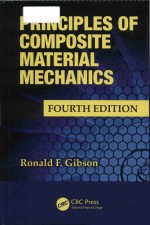图书介绍
Principles of composite material mechanicspdf电子书版本下载

- Ronald F. Gibson 著
- 出版社: Taylor & Francis Group
- ISBN:1498720692
- 出版时间:2016
- 标注页数:674页
- 文件大小:71MB
- 文件页数:700页
- 主题词:
PDF下载
下载说明
Principles of composite material mechanicsPDF格式电子书版下载
下载的文件为RAR压缩包。需要使用解压软件进行解压得到PDF格式图书。建议使用BT下载工具Free Download Manager进行下载,简称FDM(免费,没有广告,支持多平台)。本站资源全部打包为BT种子。所以需要使用专业的BT下载软件进行下载。如 BitComet qBittorrent uTorrent等BT下载工具。迅雷目前由于本站不是热门资源。不推荐使用!后期资源热门了。安装了迅雷也可以迅雷进行下载!
(文件页数 要大于 标注页数,上中下等多册电子书除外)
注意:本站所有压缩包均有解压码: 点击下载压缩包解压工具
图书目录
1.Introduction 1
1.1 Basic Concepts 1
1.2 Constituent Materials for Composites 5
1.2.1 Reinforcement Materials including Nanoreinforcements 10
1.2.2 Matrix and Filler Materials 12
1.3 Structural Applications of Composites 18
1.4 Multifunctional Applications of Composites 28
1.5 Fabrication Processes 31
1.6 Elements of Mechanical Behavior of Composites 42
1.7 Review of Basic Mechanics of Materials Equations 44
References 55
2.Lamina Stress-Strain Relationships 57
2.1 Introduction 57
2.2 Effective Moduli in Stress-Strain Relationships 58
2.3 Symmetry in Stress-Strain Relationships 62
2.4 Orthotropic and Isotropic Engineering Constants 69
2.5 Specially Orthotropic Lamina 73
2.6 Generally Orthotropic Lamina 78
References 94
3.Effective Moduli of a Continuous Fiber-Reinforced Lamina 95
3.1 Introduction 95
3.2 Elementary Mechanics of Materials Models 104
3.2.1 Longitudinal Modulus 106
3.2.2 Transverse Modulus 110
3.2.3 Shear Modulus and Poisson’s Ratio 112
3.3 Improved Mechanics of Materials Models 120
3.4 Elasticity Models 124
3.4.1 Finite Difference Models 126
3.4.2 Finite Element Models 129
3.4.3 Closed-Form and Variational Models 133
3.5 Semiempirical Models 134
References 140
4.Strength of a Continuous Fiber-Reinforced Lamina 143
4.1 Introduction 143
4.2 Multiaxial Strength Criteria 146
4.2.1 Maximum Stress Criterion 147
4.2.2 Maximum Strain Criterion 151
4.2.3 Quadratic Interaction Criteria 153
4.3 Micromechanics Models for Lamina Strength 167
4.3.1 Longitudinal Strength 168
4.3.2 Transverse Strength 176
4.3.3 In-Plane Shear Strength 180
4.3.4 Multiaxial Strength 181
References 186
5.Analysis of Lamina Hygrothermal Behavior 191
5.1 Introduction 191
5.2 Hygrothermal Degradation of Properties 193
5.3 Lamina Stress-Strain Relationships including Hygrothermal Effects 208
5.4 Micromechanics Models for Hygrothermal Properties 217
References 228
6.Analysis of a Discontinuously Reinforced Lamina 231
6.1 Introduction 231
6.2 Aligned Discontinuous Fibers 232
6.2.1 Stress and Strength Analysis 233
6.2.2 Modulus Analysis 239
6.3 Off-Axis-Aligned Discontinuous Fibers 249
6.3.1 Stress and Strength Analysis 249
6.3.2 Modulus Analysis 251
6.4 Randomly Oriented Discontinuous Fibers 260
6.4.1 Stress and Strength Analysis 261
6.4.2 Modulus Analysis 262
6.5 Nanofibers and Nanotubes 271
6.5.1 Stress and Strength Analysis 274
6.5.2 Modulus Analysis 275
6.6 Particulates 279
6.6.1 Stress and Strength Analysis 280
6.6.2 Modulus Analysis 282
6.7 Hybrid Multiscale Reinforcements 284
References 294
7.Analysis of Laminates 299
7.1 Introduction 299
7.2 Theory of Laminated Beams 300
7.2.1 Flexural Stresses and Deflections 300
7.2.2 Shear Stresses and Deflections 305
7.3 Theory of Laminated Plates with Coupling 317
7.4 Stiffness Characteristics of Selected Laminate Configurations 324
7.4.1 Specially Orthotropic Laminates 325
7.4.2 Generally Orthotropic Laminates 325
7.4.3 Symmetric Laminates 326
7.4.4 Antisymmetric Laminates 327
7.4.5 Quasi-Isotropic Laminates 327
7.5 Derivation and Use of Laminate Compliances 335
7.5.1 Inversion of Laminate Force-Deformation Equations 335
7.5.2 Determination of Lamina Stresses and Strains 337
7.5.3 Determination of Laminate Engineering Constants 338
7.5.4 Comparison of Measured and Predicted Compliances 341
7.6 Hygrothermal Effects in Laminates 350
7.6.1 Hygrothermal Degradation of Laminates 350
7.6.2 Hygrothermal Stresses in Laminates 350
7.6.3 Laminate Hygrothermal Expansion Coefficients 353
7.7 Interlaminar Stresses 354
7.8 Laminate Strength Analysis 360
7.8.1 First Ply Failure and Subsequent Ply Failures Due to In-Plane Stresses 360
7.8.2 Delamination Due to Interlaminar Stresses 363
7.9 Deflection and Buckling of Laminates 383
7.9.1 Analysis of Small Transverse Deflections 384
7.9.2 Buckling Analysis 390
7.10 Selection of Laminate Designs 394
7.11 Application of Laminate Analysis to Composite Structures 401
7.11.1 Composite Sandwich Structures 401
7.11.2 Composite Grid Structures 404
References 417
8.Analysis of Viscoelastic and Dynamic Behavior 421
8.1 Introduction 421
8.2 Linear Viscoelastic Behavior of Composites 425
8.2.1 Boltzmann Superposition Integrals for Creep and Relaxation 428
8.2.2 Differential Equations and Spring-Dashpot Models 432
8.2.3 Quasielastic Analysis 442
8.2.4 Sinusoidal Oscillations and Complex Modulus Notation 445
8.2.5 Elastic-Viscoelastic Correspondence Principle 449
8.2.6 Temperature and Aging Effects 455
8.3 Dynamic Behavior of Composites 474
8.3.1 Longitudinal Wave Propagation and Vibrations in Specially Orthotropic Composite Bars 475
8.3.2 Flexural Vibration of Composite Beams 481
8.3.3 Transverse Vibration of Laminated Plates 485
8.3.4 Analysis of Damping in Composites 492
8.4 Nanoenhancement of Viscoelastic and Dynamic Properties 502
References 514
9.Analysis of Fracture 519
9.1 Introduction 519
9.2 Fracture Mechanics Analyses of Through-Thickness Cracks 519
9.2.1 Stress Intensity Factor Approach 522
9.2.2 Strain Energy Release Rate Approach 526
9.2.3 Virtual Crack Closure Technique 530
9.3 Stress Fracture Criteria for Through-Thickness Notches 536
9.4 Interlaminar Fracture 543
9.5 Nanoenhancement of Fracture Toughness 555
References 562
10.Mechanical Testing of Composites and Their Constituents 569
10.1 Introduction 569
10.2 Measurement of Constituent Material Properties 570
10.2.1 Fiber Tests 570
10.2.2 Neat Resin Matrix Tests 573
10.2.3 Constituent Volume Fraction Measurement 576
10.3 Measurement of Basic Composite Properties 578
10.3.1 Tensile Tests 578
10.3.2 Compressive Tests 582
10.3.3 Shear Tests 585
10.3.4 Flexure Tests 594
10.3.5 Interlaminar Fracture Tests 595
10.3.6 Fiber/Matrix Interface Tests 599
10.3.7 Open-Hole and Filled-Hole Tests 601
10.3.8 Bearing Tests 602
10.3.9 Pull-Through Tests 604
10.4 Measurement of Viscoelastic and Dynamic Properties 613
10.4.1 Creep Tests 613
10.4.2 Vibration Tests 617
10.5 Measurement of Hygrothermal Properties 624
10.5.1 Glass Transition Temperature Tests 625
10.5.2 Thermal Expansion Tests 625
10.5.3 Moisture Absorption Tests 626
References 630
11.Answers to Selected Problems 639
Appendix A:Matrix Concepts and Operations 641
Appendix B:Stress Equilibrium Equations 651
Appendix C:Strain-Displacement Equations 655
Index 657